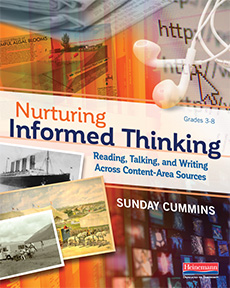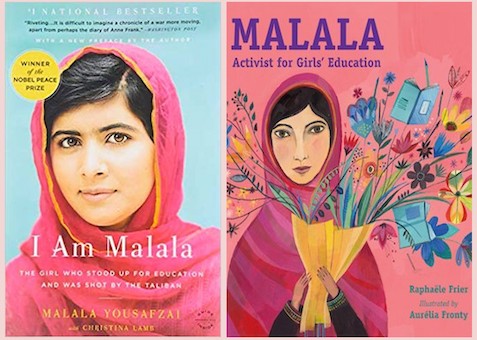Use Text Sets to Benefit Bilingual Students
By Elizabeth Hagan, Dr. Lisa Friesen, Casi Hodge and Sunday Cummins

Elizabeth
Let’s say you are asked to learn how to juggle, a skill you do not already have. You get one 30-minute lesson. You start with two balls and then three. It’s a little chaotic but with some coaching you start to get the hang of it. Then the balls disappear.

Lisa
Now you are asked to learn how to ride a unicycle. You get one lesson. It’s a little crazy. You start to gain balance. Then the unicycle disappears.
Now you are asked to learn how to rollerblade. You know what’s coming next!

Casi
BIG QUESTION: Are you exhausted? Most likely. And do you know how to juggle, ride a unicycle, or rollerblade well enough to share your learning with others? Probably not. The cognitive load of “unfamiliar” is too much. There’s a lot of new material and not enough time to master any of it.

Sunday
Now imagine you are an emergent bilingual. Perhaps you speak Arabic or Amharic at home and you are learning English at school. You’re at the expanding level on the WIDA standards for language proficiency which means you understand a lot of English but you’re not completely proficient.
Every day in school, there’s a reading lesson. Every day there’s a new text on a new unfamiliar topic. Bees. Simple machines. Harriet Tubman.
Are you exhausted? Probably. And can you talk about any topic in depth? Probably not very well. Again, there’s that cognitive overload.
As part of a professional inquiry, we began to ask ourselves how we can ease the cognitive load for emergent bilinguals so they can develop a depth of knowledge on a topic or issue while also learning how to become strategic readers.
Studying a particular topic while learning how to read strategically is powerful. Reading a second, third, and fourth source on a topic creates pathways for critical thinking.
There’s space for comparing and contrasting content, author’s craft and perspective, and developing one’s own perspective.
What emerged for us was the necessity of using sets of sources on the same topic or issue with these students. What follows are a few strategies we employ when curating these sets.
Pick High Interest and Sometimes Less Familiar Topics
The topics you choose need to be of high interest, but they don’t necessarily need to be a topic the students would come up with on their own. Many students may not be familiar with all of the rich options for topics that are available for their exploration and learning. Use what you know about your students to select new topics.
Elizabeth, our first author and a reading specialist, works closely with a group of fifth grade emergent bilinguals in a reading intervention setting. Their families are from places all over the globe. Elizabeth created a set of sources on Malala Yousafzai, the Pakistani activist for female education.
Her students had already enthusiastically studied a set of sources on how people give back to their communities so Elizabeth was pretty sure sources on Malala would be of interest to them.
Choose Sources that Complement Each Other
As students read each new source in a set, they need to notice connections between the content and ideas in that source and previously read sources. This supports students in recalling content and in thinking critically about what they are learning.
One way to make sure the sources you choose complement each other is to craft essential questions or questions that are thought provoking. As you consult different sources, these questions can act as a lens for whether the sources are relevant to the larger set.
Elizabeth crafted the following two questions to help her identify four key sources:
- What are we learning about Malala?
- Why should Malala’s story be shared and not forgotten?
The sources were in different formats including a video clip, Web pages, and traditional printed texts. Each offered at least one new nugget of information for students to ponder as they considered the essential questions.
Plan for “Transfer” with a Stack of Additional Sources
Learning about a topic or issue (and applying the strategies you have taught students) should not stop at the end of the text set you use to teach. Using knowledge they’ve developed during lessons with you, your students can continue learning without you.
Elizabeth visited the school library and checked out a stack of books on Malala. She also put together a list of digital sources including links to a video of Malala giving a speech, to the The Malala Fund website, and to books on related topics at Epic!
When she presented the students with these sources, she noticed how intentional they were in choosing sources they wanted to study. During the initial lessons, the students had asked a lot of questions that were not answered in the sources. This was a chance to do their own research.
They spent quality time looking through the sources. They used the table of contents, skim and scan strategies, and their partners to talk about which source they might be intrigued enough by to choose.
The lessons Elizabeth taught with the initial text set also included teaching a particular strategy for making sense of sources and key vocabulary. The students were able to focus more easily on learning how to be strategic readers because they were familiar in some way with the content of each source.
Elizabeth noticed as they became more confident in their learning. She also noticed them begin to use the knowledge they gained about Malala to help them think about other topics and issues.
The power of this was revealed one day, during a lesson, when a student noticed a quote by Nelson Mandela that Elizabeth has posted in her room: “Education is the most powerful weapon which you can use to change the world.” The student pointed to the quote and said “This sounds like something Malala would agree with!”
Elizabeth Hagan is a reading specialist at Crestview Elementary, North Kansas City Schools. She is a graduate of Northwest Missouri State University and holds master’s degrees in Reading and in Teacher Leadership. In 2018 she achieved National Board Certification in Literacy: Reading- Language Arts/ Early and Middle Childhood.
Dr. Lisa Friesen is a District Instructional Coordinator for North Kansas City Schools, with a focus on coordinating MTSS – academic and behavior interventions. She is a graduate of the University of Kansas with a Bachelor’s in Elementary Education, Masters in Special Education and Doctorate in Teaching & Learning with an emphasis in Literacy.
Casi Hodge (casi.hodge@nkcschools.org) is currently a District Instructional Coordinator for the North Kansas City School District in Kansas City, MO. She holds a master’s degree in Administration and a bachelor’s degree in Elementary Education. Casi spent 12 years as a classroom teacher teaching multiple grade levels before shifting into the role of reading teacher.

Sunday is the author of several professional books, including her latest releases, Close Reading of Informational Sources (Guilford, 2019), and Nurturing Informed Thinking (Heinemann, 2018). Visit her website and read her regular blog posts on teaching information literacy. Follow her on Twitter @SundayCummins.



































I learned about text sets in my 3rd year of teaching. Life changed after that! Thank you for sharing the article and supporting students multlingualism!